|
Note: Before calling attention to the Prunus genus of delectable summer fruits, there’s a botany lesson. We love brief glimpses of botany in food writing!
In botany, a drupe—the botanical name for stone fruit—is a fruit in which an outer fleshy part (exocarp, or skin; and mesocarp, or flesh) surrounds a shell (called the pit, stone, or pyrene) of a hardened endocarp with a seed (kernel) inside.
A picture is worth a thousand words, so check out the third photo.
There are two main classes of fleshy fruits: drupes and berries.
Drupes are characterized by having a fleshy mesocarp but a tough-leathery or bony endocarp. They are said to have “stones” or “pits” rather than seeds (example: peaches). A drupe usually has a single seed.
Berries, to the contrary, are characterized by having a fleshy endocarp, as well as mesocarp, and may have more than one seed.
Yet, you can’t assume too much. Avocado is a berry: It does not have a stony endocarp (the pit or stone) covering the seed—as those who have tried growing a plant from the seed are well aware.
Drupes are members of the Rosaceae family, also called the rose family. The family includes both ornamental shrubs and trees and those with edible fruits.
Drupes are members of the genus Prunus. Strawberries are cousins from another genus; apples, pears, and quince from another; and loquats from yet another.
DRUPES YOU’VE EATEN
Drupes are popular fruits in the U.S. and Europe. The family includes:
Hand fruits: apricot, cherry, damson, nectarine, peach, plum and hybrids like apriums, plumcots and pluots
Tropical fruits: coconut, mango
Surprise drupes (typically not eaten raw): almonds*, coffee†, hickory nuts*, olives, pecans*, most palms (including date, sabal, coconut, and oil palms), pistachios*, walnuts*
Exotic (in the U.S.): jujube, white sapote
Let’s move on, leaving drupes behind in favor of stone fruits, the genus’ common name.
DIG IN NOW!
Stone fruits are summer treats. You’ve got another month to enjoy them fresh off the tree.
Beyond eating them as hand fruit, use them to make:
Drinks.
Ice creams and sorbets.
Pastries, pies, shortcakes, and tarts.
Or:
Grill, poach, or stew them as sides or desserts (Alone? With ice cream? With pound cake?.
Pickle them. Poach and stew them to serve alone or with ice cream and or pound cake.
In earlier times, fruits like these were “put away” in cans and jars and made into jams to enjoy until the next year’s crops came in.
Now, when you see peaches and other stone fruits in the colder months, they most likely come from Chile or elsewhere below the equator, where the seasons are reversed.
STONE FRUIT RECIPES
You can fine droves of stone fruit recipes all over the web. Some specialty sites include:
California Cherries
California Fresh Fruit Association
Choose Cherries
Georgia Peach Growers
Northwest Cherries
Oregon Cherry Growers
Washington Cherry Growers
Washington State Fruit Commission
__________________
*These tree nuts are the seeds of the fruits of the tree: With these species of drupes, we eat the seed inside the pit instead of the fruit surrounding it. They are not true nuts.
†The cherries from the coffee tree enclosed the seeds, which are roasted to become coffee beans.
|
|
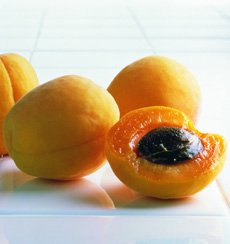
[1] Apricots showing a pit, a.k.a. stone. All drupes have a hard stone-like pit at the center (photos #1 and #2 © Washington State Fruit Commission).
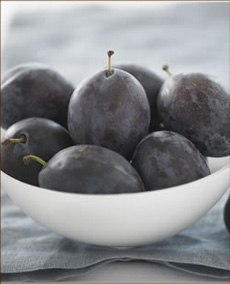
[2] A bowl of plums.
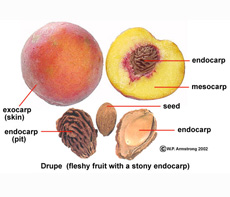
[3] The anatomy of the peach and other drupes (illustration © W.P. Armstrong).
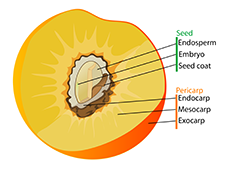
[4] A close-up on the anatomy of a peach, perhaps the most popular drupe (illustration © Lady Of Hats | Wikipedia`).
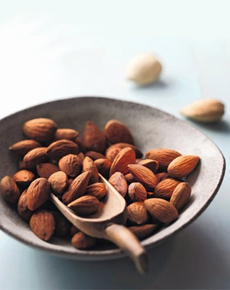
[5] Almonds (and pistachios) are stone fruits, not true nuts (photo © Niederegger Marzipan | Facebook).

[6] Surprise drupes: (photo © Baldor Specialty Foods).
|








